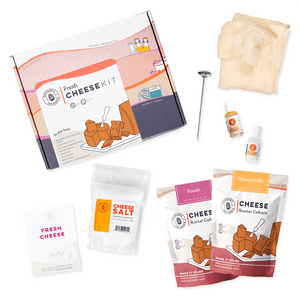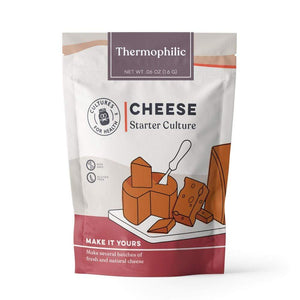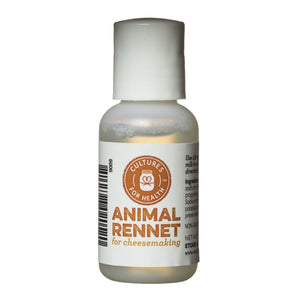
This alternative recipe for parmesan cheese does not use the lipase flavor additive, and is made with skim milk rather than whole milk.
30 minutes
180 minutes
4
INGREDIENTS AND EQUIPMENT AVAILABLE AT CULTURES FOR HEALTH
Fresh Cheese Making Kit

Fresh Cheese Making Kit
$45.99
Our most comprehensive choice, the Fresh Cheese Kit contains two starter cultures and supplies to make five different varieties of soft cheese - feta, cottage cheese, cream cheese, fromage blanc, and traditional quark. Kit contains a Mesophilic Cheese Culture, a Fresh Cheese Culture, calcium chloride, vegetable rennet, cheese salt, butter muslin, a thermometer, and an instruction and recipe card.
Packaging and Equipment in the kit may appear different than pictured.
Thermophilic Starter Culture

Thermophilic Starter Culture
$19.99
This useful culture makes a variety of hard cheeses, including parmesan, romano, provolone, and swiss.
Liquid Animal Rennet

Liquid Animal Rennet
$12.99
High quality single strength animal rennet. This non-GMO animal rennet is preferred for aged cheese as it creates a more desirable flavor and aroma during the aging process. Each bottle contains enough rennet to set (12) 2-gallon batches of cheese.
Cheese Salt

INGREDIENTS:
- 2 gallons skim milk
- 1/4 tsp. thermophilic starter culture
- 1/2 tsp. liquid rennet dissolved in ¼ cup cool water
- Cheese salt
- Olive oil (for rubbing)
INSTRUCTIONS:
- Heat milk to 94°F using a hot water bath. The temperature should be brought up slowly, over about 20 minutes. When the milk is at 94°F, remove the pot of milk from the heat source.
- Sprinkle the starter over the milk and allow it to rehydrate for 5 minutes before whisking it in thoroughly.
- Cover and maintain temperature for 45 minutes while the milk ripens.
- Add the diluted rennet and slowly whisk in for 1 minute or so. Cover and allow to set for 45 minutes. When you have a clean break, use a whisk to cut the curd into 1/4-inch pieces. Let the curds rest for 10 minutes.
- Slowly raise the temperature to 124°F. This should take about an hour. Keep stirring to keep the curds from sticking together (matting) and to firm them up a bit. When the temperature reaches 104°F, stop stirring and allow the curds to settle and mat for the duration of the heating period, or until the temperature reaches 124°F. Once you have achieved this temperature, cover the pot and maintain the temperature for 10 minutes.
- Line a colander with damp butter muslin. Suspend it over a large bowl or sink. Ladle the matted curds into it, and let them drain for 5 minutes. Transfer the curds (in the butter muslin) to a 5-inch tomme mold or 8-inch cheese press. Let them continue to drain for 10 more minutes.
- Pull up the ends of the butter muslin and fold the ends over the top of the curds. Place the follower on top. Press at 10 pounds for 30 minutes.
- Pull the cheese out of the mold, peel away the cloth, flip the cheese over, and rewrap it in the cloth. Press again at 10 pounds but this time for 1 hour.
- Remove, undress, flip, and re-dress the cheese again. Place it back into the mold and press at 10 pounds for 12 hours.
- While the cheese is being pressed, prepare a near-saturated brine (about 30-ounces of salt to 1 gallon of water) and put it into the refrigerator with a lid on it to chill. It should be about 50° to 55°F.
- Remove the cheese from the mold and peel away the butter muslin. Take the brine out of the refrigerator and pour it into a container big enough to hold the wheel of cheese. Place the cheese in the brine and put the container of brine and cheese back into the refrigerator. Let the cheese soak for 12 hours in this manner, flipping it over halfway through the brining time.
- Take the cheese out of the brine and pat it dry with a clean towel. Place it on a cheese mat or drying rack. Let it dry at room temperature for 1 to 2 days, or until it is dry to the touch. Continue flipping the cheese every now and again during this drying period.
- Age the cheese in a ripening box or cold cellar (at 50-55°F) for 2 weeks, flipping once every day. After this time, continue to age for 3 months, flipping it once a week. After three months, rub the entire surface of the cheese with olive oil. Continue to rub with oil every 3 months of aging.
- If any unwanted mold develops on the rind of the parmesan, use a bit of cheesecloth wet in a vinegar water solution to wipe it away, and oil the cheese again.

If you are patient enough, this cheese is great if aged for up to a year, but you can eat and enjoy it around the 7-month point. Once the cheese has been cut into, it will store best if wrapped in cheese paper and stored in the refrigerator.















